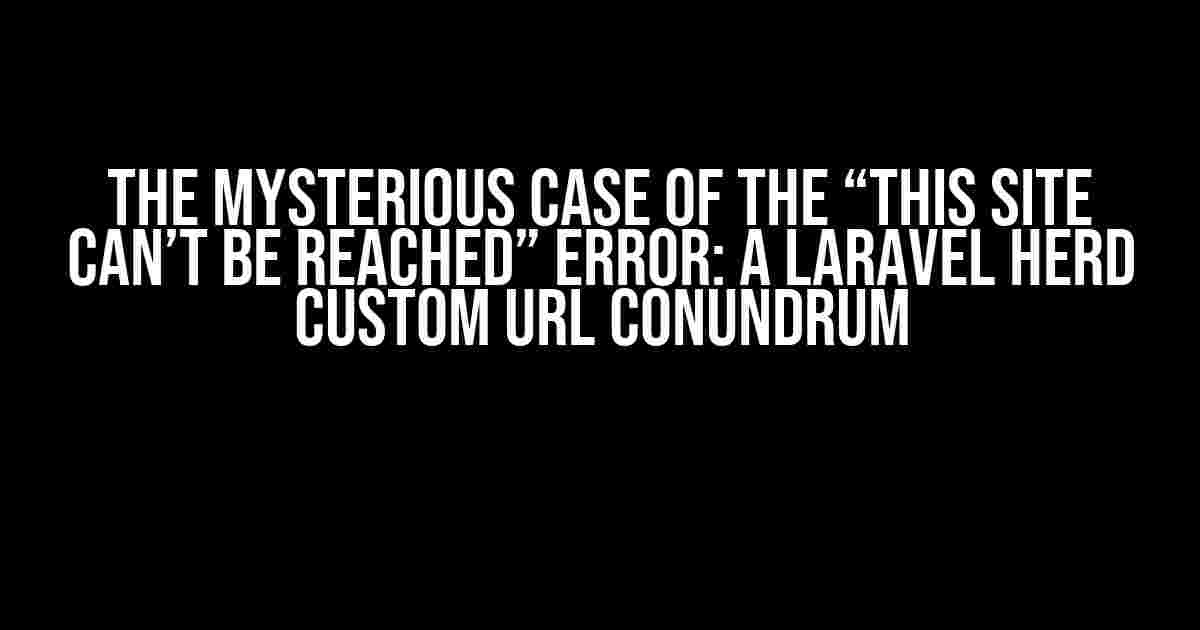The Symptoms: A Recap of the Issue
- You’ve set up a custom URL for your Laravel Herd site.
- When accessing the site, you’re met with a “This site can’t be reached” error message.
- Other sites on the same server or network are working fine.
- You’ve checked the server logs and can’t find any obvious errors.
The Usual Suspects: Common Causes and Quick Fixes
1. DNS Propagation
DNSChecker to check the DNS status of your domain.
2. URL Configuration
' url' => 'https://your-custom-url.com',
3. Server Configuration
Nginx Configuration Tester to test your Nginx configuration.
The Deep Dive: Uncovering the Root Cause
1. SSL Certificate Issues
SSL Shopper to check your SSL certificate status.
2. Laravel Herd Cache Issues
php artisan herd:cache:clear
3. Route Caching
php artisan route:cache
Advanced Troubleshooting: The Nuclear Option
1. Enable Debug Mode
'debug' => true,
2. Check Server Logs
Laravel Log Viewer to view your server logs.
3. Use a Network Sniffer
Wireshark to capture network traffic and analyze the HTTP requests and responses. This can help you identify any issues with your custom URL.
The Fix: A Comprehensive Solution
- Clear the Laravel Herd cache using the command:
php artisan herd:cache:clear - Clear the route cache using the command:
php artisan route:cache - Verify that your SSL certificate is correctly configured and up-to-date.
- Check your server logs for any error messages related to your custom URL.
- Use a network sniffer to capture network traffic and analyze the HTTP requests and responses.
- Verify that your Laravel Herd configuration files are correct and match the custom URL you’re trying to access.
- Check your server’s DNS configuration to ensure that the custom URL is properly routed.
Conclusion: The Mystery Solved
| Troubleshooting Step | Fix |
|---|---|
| DNS Propagation | Wait for 24-48 hours or use DNSChecker to check DNS status |
| URL Configuration | Verify Laravel Herd configuration files and update if necessary |
| Server Configuration | Verify server configuration files and update if necessary |
| SSL Certificate Issues | Verify SSL certificate configuration and update if necessary |
| Laravel Herd Cache Issues | Clear Laravel Herd cache using php artisan herd:cache:clear |
| Route Caching | Clear route cache using php artisan route:cache |
Frequently Asked Question
Laravel Herd custom URL sites show “This site can’t be reached”? Get the answers to your questions here!
Why do I see “This site can’t be reached” when accessing my Laravel Herd custom URL site?
This error usually occurs when there’s a misconfiguration in your DNS settings or server setup. Double-check that your domain’s DNS settings are correctly pointed to your server’s IP address, and make sure your server is properly configured to handle the custom URL.
Could this be related to a Laravel-specific issue?
Possibly! Laravel has its own routing mechanism, which might be causing the issue. Check your Laravel routes configuration to ensure that the custom URL is correctly defined. Also, verify that the route is not conflicting with any other routes.
How do I troubleshoot the issue further?
Start by checking your server’s error logs to see if there are any clues about the issue. You can also use tools like ` ping` or `dig` to test your DNS settings. Additionally, try accessing your site using the server’s IP address instead of the custom URL to isolate the problem.
What if I’ve checked everything and still can’t access my site?
If you’ve exhausted all troubleshooting steps, it might be worth reaching out to your server administrator or hosting provider for assistance. They may be able to provide more insight into the issue or help you resolve it.
Are there any Laravel-specific tools that can help me diagnose the issue?
Yes! Laravel has a built-in debug tool called `telescope` that can help you debug and troubleshoot issues like this. You can also use third-party packages like `laravel-debugbar` to get more insights into your application’s behavior.
